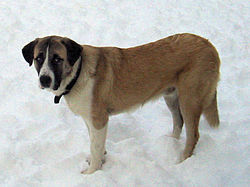Rafeiro do Alentejo
 From Wikipedia - Reading time: 8 min
From Wikipedia - Reading time: 8 min
| Rafeiro do Alentejo | |||||||||||||||||||||||||
|---|---|---|---|---|---|---|---|---|---|---|---|---|---|---|---|---|---|---|---|---|---|---|---|---|---|
 | |||||||||||||||||||||||||
| Other names |
| ||||||||||||||||||||||||
| Origin | Portugal | ||||||||||||||||||||||||
| |||||||||||||||||||||||||
| |||||||||||||||||||||||||
| Dog (domestic dog) | |||||||||||||||||||||||||
The Rafeiro do Alentejo[a] or Rafeiro Alentejano is a Portuguese breed of flock guardian dog. It is named for its area of origin, the Alentejo region of southern Portugal.[2]: 33 It is recognised by the Clube Português de Canicultura,[3] and was definitively accepted by the Fédération Cynologique Internationale in 1954.[1]
History
[edit]The Rafeiro is a traditional flock guardian dog of the Alentejo region of southern Portugal. Dogs of this type were used to protect flocks during the biannual transhumance to high summer pastures in the mountains, and then back to the lowlands for the winter.[4] In the late nineteenth century they began to be known as Rafeiro do Alentejo.[5]: 253 [4] The earliest breed standard dates from 1953; the breed was definitively accepted by the Fédération Cynologique Internationale in the following year.[1]
Among the marked economic and social changes in Portugal in the 1970s was the large-scale movement of people from rural areas to towns and cities, one consequence of which was an abrupt and significant decrease in pastoral farming.[5]: 253 Flock guardian dogs were no longer needed, and numbers of the Rafeiro fell sharply, to the point that by the early 1980s it was close to extinction, with only a few dogs remaining in the hands of a small group of breeders.[5]: 253
A breed club, the Associação dos Criadores do Rafeiro do Alentejo, was established in 1994 in Monforte, in the District of Portalegre; it was a successor to an earlier club, the Clube Português do Rafeiro do Alentejo.[5]: 253 [6][7]. The society and the câmara municipal of Monforte jointly established a breeding centre for the dogs, the Centro de Reprodução do Rafeiro do Alentejo, in the town.[5]: 253
In 2006 there were 1165 bitches registered in the stud-book.[8] The area of distribution of the Rafeiro corresponds closely with the historic region of Alentejo, with the exception of areas closest to the Atlantic coast.[8]
A dog of this breed named Bobi was confirmed by Guinness World Records to be both the oldest living dog and the oldest dog ever, with a claimed age of 30 years and 226 days on 1 February 2023.[9][10] He died at the claimed age of 31 years and 165 days on 21 October 2023.[11] Doubts about the claims were expressed by veterinary surgeons, and Guinness opened an investigation; it found insufficient evidence of the age of the dog, and the records were annulled.[12][13][14]
Characteristics
[edit]The Rafeiro is a large dog, slightly longer than it is tall, with a broad chest. The head is massive; the eyes are small and dark, the ears small, triangular and hanging. The coat is dense and straight, of short or medium length. It may be black, fawn, wolf grey or yellow, either brindled or not, but always with white markings; or may be white marked with these colours.[4] It is not as thick as the coat of other pastoral dogs such as the Polish Tatra.[15]
Use
[edit]The traditional use of the Rafeiro was as a flock guardian dog, used to protect extensively-managed flocks from predators.[5]: 253 It was also used in hunting for large game; historic photographs show that it was among the dogs in the hunting packs of Carlos I, who had a palace in Alentejo.[5]: 253 In the twenty-first century the dogs are used to guard farms and other property as well as flocks, and are also kept as companion animals.[5]: 253
Notes
[edit]- ^ Portuguese pronunciation: [ʁɐˈfɐj.ɾu ðu ɐ.lẽˈtɛ.ʒu][citation needed]
References
[edit]- ^ a b c d e f g Rafeiro do Alentejo (96). Fédération Cynologique Internationale. Accessed March 2020.
- ^ Gino Pugnetti, Elizabeth Meriwether Schuler (1980). Simon & Schuster's Guide to Dogs. New York; London; Toronto; Sydney; Tokyo; Singapore: Simon & Schuster. ISBN 0671255274.
- ^ Rafeiro do Alentejo (in Portuguese). Lisboa: Clube Português de Canicultura. Accessed May 2023.
- ^ a b c FCI-Standard N° 96: Rafeiro do Alentejo (Rafeiro of Alentejo). Thuin, Belgium: Thuin, Belgium: Fédération Cynologique Internationale. Accessed May 2023.
- ^ a b c d e f g h [s.n.] (2021). Catálogo Oficial de Raças Autóctones Portuguesas (in Portuguese). Lisboa: Confederação dos Agricultores de Portugal; Direção-Geral de Alimentação e Veterinária. Archived 19 January 2024.
- ^ Clubes Filiados (in Portuguese). Lisboa: Clube Português de Canicultura. Accessed May 2023.
- ^ A ACRA (in Portuguese). Monforte, Portugal: Associação de Criadores do Rafeiro do Alentejo. Accessed May 2023.
- ^ a b Cães – Raça Rafeiro Alentejano (in Portuguese). Vale de Santarém: Sociedade Portuguesa de Recursos Genéticos Animais. Archived 17 September 2024.
- ^ Kathryn Armstrong (3 February 2023). Bobi breaks Guinness World Record for oldest dog ever. BBC News. Accessed October 2023.
- ^ Sanj Atwal (2 February 2023). Oldest dog EVER record broken by 30-year-old Bobi from Portugal. London: Guinness World Records Limited. Accessed May 2023.
- ^ Kathryn Armstrong (23 October 2023). Bobi, the world's oldest dog ever, dies aged 31. BBC News. Accessed October 2023.
- ^ Kim Willsher (22 February 2024). Bobi the Portuguese mastiff stripped of record as world's oldest ever dog. London: The Guardian. Archived 22 February 2024.
- ^ Ido Vock (22 February 2024). Former world's oldest dog stripped of title. BBC News. Archived 22 February 2024.
- ^ Vicki Newman (22 February 2024). Guinness World Records concludes oldest dog ever review launched after Bobi's death. London: Guinness World Records Limited. Accessed May 2023.
- ^ David Hancock (2014). Dogs of the Shepherds: A Review of the Pastoral Breeds. Ramsbury, Marlborough: The Crowood Press. ISBN 9781847978097.
 KSF
KSF